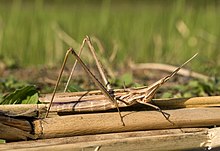Acrida cinerea
| Acrida cinerea | |
|---|---|

| |
| Scientific classification | |
| Domain: | Eukaryota |
| Kingdom: | Animalia |
| Phylum: | Arthropoda |
| Class: | Insecta |
| Order: | Orthoptera |
| Suborder: | Caelifera |
| Family: | Acrididae |
| Subfamily: | Acridinae |
| Tribe: | Acridini |
| Genus: | Acrida |
| Species: | A. cinerea
|
| Binomial name | |
| Acrida cinerea (Thunberg, 1815)
| |
Acrida cinerea, sometimes called the Oriental longheaded grasshopper/locust[1] or the Chinese grasshopper[2][better source needed] (though this name is also applied to Oxya chinensis),[citation needed] is a member of the Acrididae family. Like other members of the genus Acrida, Acrida cinerea lacks stridulatory organs on its legs and so they do not make noise whilst moving.[2][better source needed]
Historically it has been used as a human food source,[2][better source needed] and it has been investigated for its nutritional value for the poultry industry (e.g., Wang et al. 2007[3]).
Description
Acrida cinerea males are typically 40–50 mm (1.6–2.0 in) in length while females are 70–80 mm (2.8–3.1 in).[1] They are either green or brown in color with colorless wings.[2][better source needed] A. cinerea has long legs which allow it to jump long distances.
References
- ^ a b Rowan Hooper. "Oriental long-headed locust". The Japan Times. Retrieved 2018-05-20.
- ^ a b c d Dana Campbell. "Chinese Grasshopper - Acrida cinerea - Details - Encyclopedia of Life". Encyclopedia of Life. Retrieved 2018-05-20.
- ^ Wang, Dun; Zhai, SW; Zhang, Chuan-Xi; Zhang, Qiang; Chen, Hui (2007). "Nutritional value of Chinese grasshopper Acrida cinera (Thumberg) for broilers". Animal Feed Science and Technology. 135: 66–74. doi:10.1016/j.anifeedsci.2006.05.013. Retrieved 2018-05-20.
External links
 Media related to Acrida cinerea at Wikimedia Commons
Media related to Acrida cinerea at Wikimedia Commons
